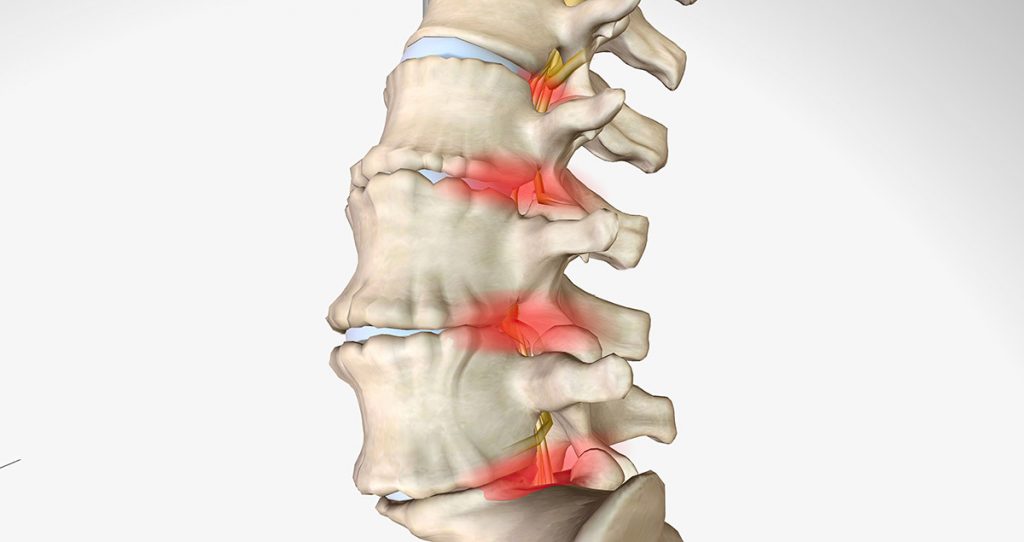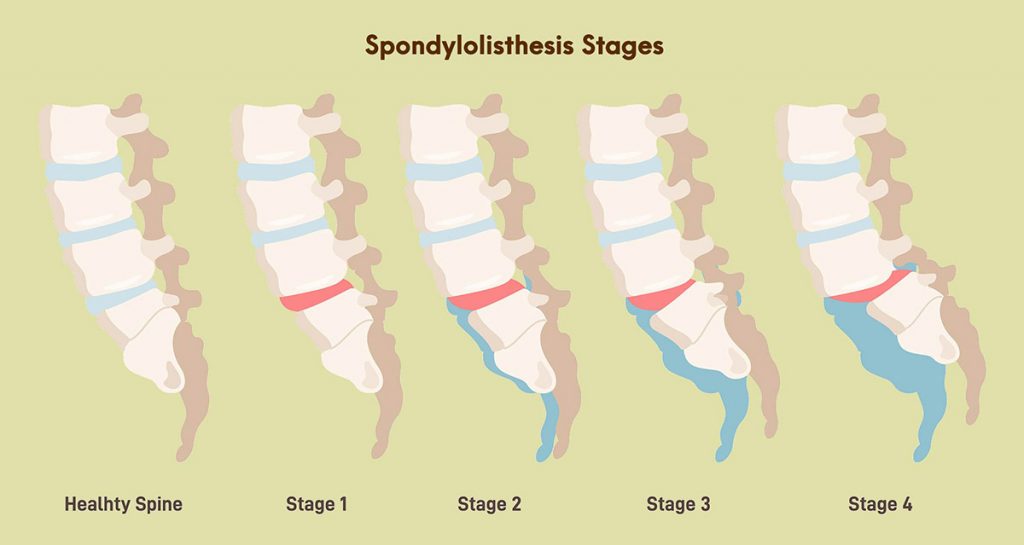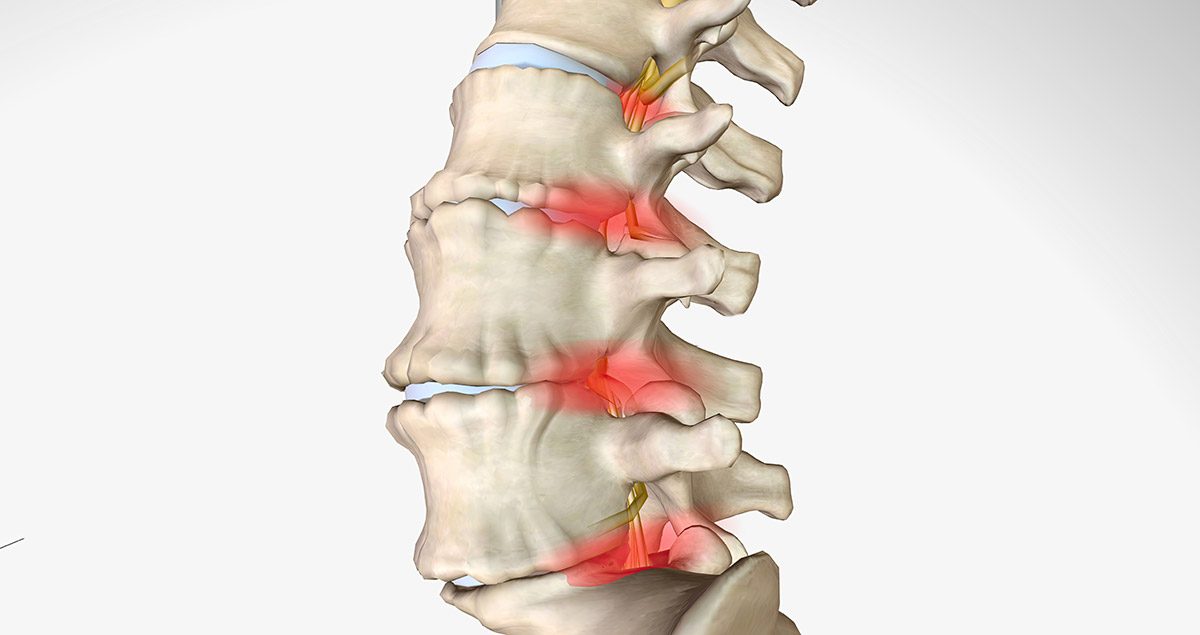Spondylolisthesis
![]()
Call (703) 520-1031 or use the form to send us your contacts.

Spondylolisthesis, a condition primarily associated with aging, affects the spinal joints and discs, resulting in the displacement of one or more vertebrae. It is a prevalent arthritis condition, affecting over 85% of men and women aged 60 years or older. However, spondylolisthesis can also be caused by factors other than arthritis, and the severity of the condition dictates the treatment plan.
What is Spondylolisthesis?
Deterioration of the bones or discs in the spine for any reason can lead to a condition called spondylolisthesis, in which a vertebra changes position relative to the vertebra above or below it. A spinal bone slides forward over another spinal bone below it. This means one vertebra is pressing down on the one below it.
Although the condition can develop anywhere along the spine, lumbar spondylolisthesis and cervical spondylolisthesis are the most common types. Lumbar spondylolisthesis has received more attention because it often causes lower back pain. Yet, cervical spondylolisthesis has more potential to develop severe symptoms due to nerve compression in the spinal cord.
The cervical spine contains the spinal cord. When cervical spine degeneration progresses, the cervical facet joints degenerate, and their orientation changes. If the spinal cord is severely compressed due to vertebral slippage, the individual may experience neurological symptoms, including paralysis or loss of bowel or bladder control. Researchers believe that degeneration of the cervical facet joints and the muscles maintaining the cervical spine may decrease neck stability and contribute to the progression of degenerative cervical spondylolisthesis.
The lower spine has nerve roots that branch out from the spinal cord. Since, the spinal cord ends higher in the spine, it is less at risk of compression. This potentially makes lumbar spondylosis less dangerous medically, even if it is painful.
Causes
There are five common causes of spondylolisthesis.
1. Degenerative Spondylolisthesis
Spinal osteoarthritis or spondylosis is a condition in which the spine’s facet joints and discs deteriorate. Neck arthritis is a top cause of cervical degenerative spondylolisthesis.
2. Isthmic Spondylolisthesis
Also called spondylolysis, isthmic spondylolisthesis is caused by a defect in the pars interarticularis, a narrow, bony bridge connecting the facet joints, which is important to neck stability. It is susceptible to fatigue fractures from repetitive neck hyperextension, as seen in young athletes. The pars interarticularis may also experience an acute fracture from an injury due to falling or a direct impact of some type.
3. Traumatic Spondylolisthesis
This refers to a fracture or dislocation of posterior (back of a structure) spinal elements, excluding the pars interarticularis. A high-energy injury, like a car accident, is often the cause of vertebral slippage.
4. Dysplastic Spondylolisthesis
This type of spondylolisthesis is caused by an abnormality at birth. For example, a child is born with a vertebral bone that is thinner than it should be.
5. Pathologic Spondylolisthesis
Pathologic spondylolisthesis develops as a result of a disease that weakens the vertebral structure.
Symptoms
Many people may not be aware of the condition developing in their spine, as spondylolisthesis can be asymptomatic. When symptoms develop, they cover a wide range.
1. Stiffness
One of the common causes of neck stiffness and pain associated with cervical spondylolisthesis is spinal osteoarthritis. Stiffness or tightness in the thigh area is a symptom of lumbar spondylolisthesis.
2. Weakness, numbness and tingling
These symptoms in the arms, legs, hands, or feet may indicate that cervical spondylosis has caused a narrowing of the spinal canal in one or more vertebrae. The legs and/or the buttocks may experience a tingling sensation or numbness.
3. Pain
The location of the pain usually depends on the site of the spondylolisthesis. It may include buttock pain, leg pain, lower back pain or neck pain. Sometimes, pain can radiate from the neck or lower back into other parts of the body. Neck or back pain may feel worse when sneezing or coughing.
4. Difficulty walking
An unsteady gait can develop due to a combination of factors. They include leg pain and weakness, muscle weakness, nerve compression and pain.
5. Muscle spasms
Muscle spasms can develop due to nerve irritation and muscle strain. The spasms are a sign that the body is trying to stabilize the spine and protect itself.
6. Loss of bowel or bladder control
Due to nerve damage, these symptoms only develop in the worst cases.
With cervical spondylolisthesis, a clicking sound may be heard in the neck or a grinding sensation may be felt when turning the head.

Who is at Risk of Developing Cervical Spondylolisthesis?
As mentioned, degenerative spondylolisthesis is common in people over 60. It is usually due to arthritis, especially in women. That is why it is considered a disease of aging, but it can develop in people at any age. The people at risk of developing cervical spondylolisthesis includes the following.
- People over 60 years old due to arthritis
- Young athletes who experience repetitive hyperextension
- Individuals in jobs requiring frequent neck movements that lead to hyperextension, jobs placing significant loads on the neck and jobs requiring difficult positions
- People who have bone-weakening diseases like osteoporosis
- Individuals who have had surgery on their cervical spine
- Individuals who had experienced a prior injury to the cervical spine
- People born with a congenital malformation of the cervical vertebrae
Some researchers suggest that there may be a genetic predisposition in some individuals. However, more research is needed.
Treatment
There are two types of treatment approaches for neck pain relief: non-surgical and surgical.
For most individuals, non-surgical treatment options provide effective relief from spondylolisthesis. These options include the following.
- Taking nonsteroidal medications
- Getting steroid and pain-relieving injections around face joints and nerves
- Applying ice or heat packs
- Attending physical therapy sessions
- Making lifestyle changes, i.e., losing weight
Surgery is typically reserved for severe cases in which non-surgical options are proving inadequate.
1. Spinal fusion
A spinal fusion procedure fuses two or more vertebrae to stabilize the spine.
2. Decompression
A surgeon can also remove vertebral bone, including bone spurs and arthritis, to relieve pressure on a nerve.
FAQ
Can I still play sports with this condition?
The answer to whether it is safe to continue playing sports depends on the severity of the cervical spondylosis and whether the sport involves contact and collision. The danger lies in the fact that an athlete who has cervical stenosis has a higher risk of incurring permanent nerve damage if the cervical spine is injured again. An athlete (or anyone) with cervical spondylosis and experiencing symptoms should not play contact sports.
Do exercises help with cervical spondylosis?
Some exercises may help relieve symptoms of cervical spondylosis. Exercises that improve movement and neck strength include chin tucks, side head tilts, neck rotations, lateral neck flexion exercises and neck extensions. A holistic exercise program could include low-impact aerobic exercises and exercises like shoulder blade squeezes.
Our spine specialists can develop an exercise plan tailored to meet the patient’s specific needs.
Is cervical spondylosis dangerous?
Yes, cervical spondylosis can be dangerous when it causes cervical spondylotic myelopathy. This is a condition in which there is nerve compression from a narrowing of the spinal canal, which can lead to neurological damage. The damage includes numbness and weakness in the legs or arms, making walking difficult, as well as loss of bowel and bladder control. Pain can become debilitating. There are rare cases in which cauda equina syndrome develops. This condition affects the nerves at the bottom of the spinal cord.
Can cervical spondylosis be cured completely?
Cervical spondylosis cannot be cured completely. It is a chronic spinal condition. Fortunately, it can usually be managed with a non-surgical cervical spondylosis treatment plan and lifestyle changes that prevent many of the symptoms.
